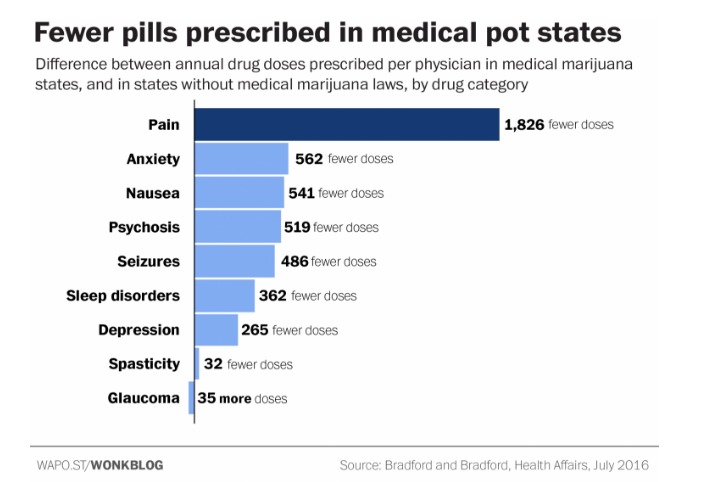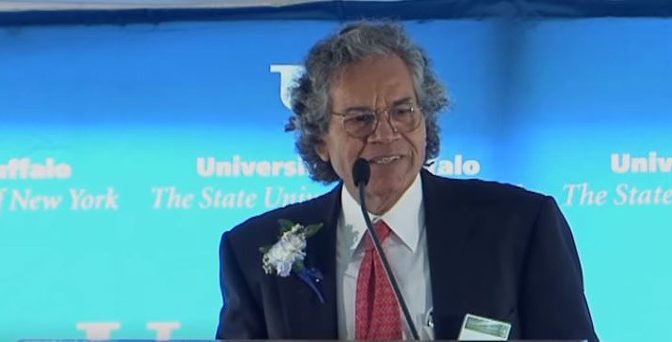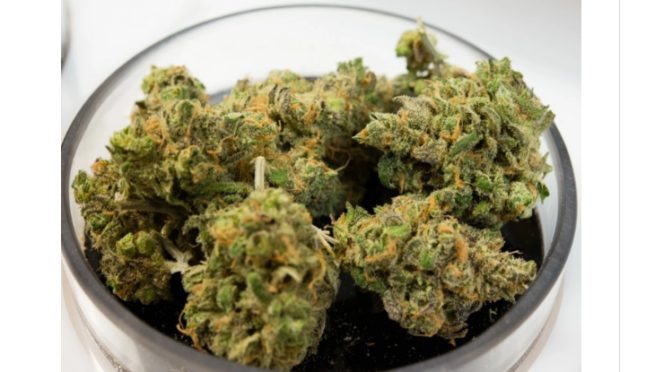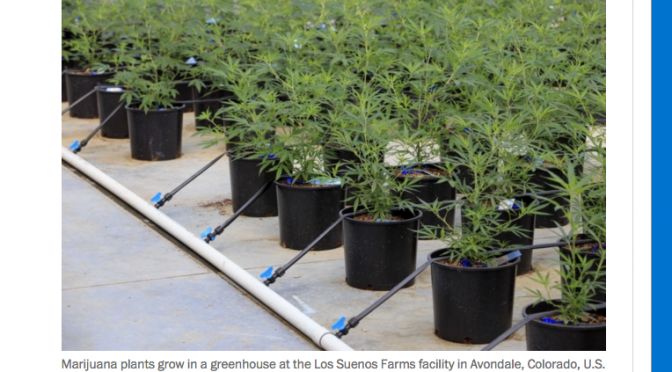Tag Archives: marijuana legalization
Why pharma companies are fighting legal marijuana

There’s a body of research showing that painkiller abuse and overdose are lower in states with medical marijuana laws. These studies have generally assumed that when medical marijuana is available, pain patients are increasingly choosing pot over powerful and deadly prescription narcotics. But that’s always been just an assumption.
Now a new study, released in the journal Health Affairs, validates these findings by providing clear evidence of a missing link in the causal chain running from medical marijuana to falling overdoses. Ashley and W. David Bradford, a daughter-father pair of researchers at the University of Georgia, scoured the database of all prescription drugs paid for under Medicare Part D from 2010 to 2013.
They found that, in the 17 states with a medical-marijuana law in place by 2013, prescriptions for painkillers and other classes of drugs fell sharply compared with states that did not have a medical-marijuana law. The drops were quite significant: In medical-marijuana states, the average doctor prescribed 265 fewer doses of antidepressants each year, 486 fewer doses of seizure medication, 541 fewer anti-nausea doses and 562 fewer doses of anti-anxiety medication.
But most strikingly, the typical physician in a medical-marijuana state prescribed 1,826 fewer doses of painkillers in a given year.
These conditions are among those for which medical marijuana is most often approved under state laws. So as a sanity check, the Bradfords ran a similar analysis on drug categories that pot typically is not recommended for — blood thinners, anti-viral drugs and antibiotics. And on those drugs, they found no changes in prescribing patterns after the passage of marijuana laws.
“This provides strong evidence that the observed shifts in prescribing patterns were in fact due to the passage of the medical marijuana laws,” they write.
In a news release, lead author Ashley Bradford wrote, “The results suggest people are really using marijuana as medicine and not just using it for recreational purposes.”
One interesting wrinkle in the data is glaucoma, for which there was a small increase in demand for traditional drugs in medical-marijuana states. It’s routinely listed as an approved condition under medical-marijuana laws, and studies have shown that marijuana provides some degree of temporary relief for its symptoms.
The Bradfords hypothesize that the short duration of the glaucoma relief provided by marijuana — roughly an hour or so — may actually stimulate more demand in traditional glaucoma medications. Glaucoma patients may experience some short-term relief from marijuana, which may prompt them to seek other, robust treatment options from their doctors.
The tanking numbers for painkiller prescriptions in medical marijuana states are likely to cause some concern among pharmaceutical companies. These companies have long been at the forefront of opposition to marijuana reform, funding research by anti-pot academics and funneling dollars to groups, such as the Community Anti-Drug Coalitions of America, that oppose marijuana legalization.
Read Full Article – https://www.washingtonpost.com/news/wonk/wp/2016/07/13/one-striking-chart-shows-why-pharma-companies-are-fighting-legal-marijuana/
Study: There’s no scientific basis for laws regulating marijuana and driving
WASHINGTON (AP) — Six states that allow marijuana use legal tests to determine driving while impaired by the drug that have no scientific basis, according to a study by the nation’s largest automobile club that calls for scrapping those laws.
The study commissioned by AAA’s safety foundation said it’s not possible to set a blood-test threshold for THC, the chemical in marijuana that makes people high, that can reliably determine impairment.
Yet the laws in five of the six states automatically presume a driver guilty if that person tests higher than the limit, and not guilty if it’s lower.
As a result, drivers who are unsafe may be going free while others may be wrongly convicted, the foundation said.
The foundation recommends replacing the laws with ones that rely on specially trained police officers to determine if a driver is impaired, backed up by a test for the presence of THC rather than a specific threshold. The officers are supposed to screen for dozens of indicators of drug use, from pupil dilation and tongue color to behavior.
The foundation’s recommendation to scrap the laws in Colorado, Montana, Nevada, Ohio, Pennsylvania and Washington comes as legislatures in several more states consider adopting similar laws.
At least three states, and possibly as many as eleven, will vote this fall on ballot measures to legalize marijuana for either recreational or medicinal use, or both. Several legislatures are also considering legalization bills.
“There is understandably a strong desire by both lawmakers and the public to create legal limits for marijuana impairment in the same manner we do alcohol,” said Marshall Doney, AAA’s president and CEO. “In the case of marijuana, this approach is flawed and not supported by scientific research.”
Determining whether someone is impaired by marijuana, as opposed to having simply used the drug at some time, is far more complex than the simple and reliable tests that have been developed for alcohol impairment.
There’s no science that shows drivers become impaired at a specific level of THC in the blood. A lot depends upon the individual. Drivers with relatively high levels of THC in their systems might not be impaired, especially if they are regular users, while others with relatively low levels may be unsafe behind the wheel.
Full Article – http://www.businessinsider.com/study-theres-no-scientific-basis-for-laws-regulating-marijuana-and-driving-2016-5
What today’s Supreme Court decision means for the future of legal weed
The Supreme Court’s decision today to toss out a lawsuit that could have brought Colorado’s legal marijuana boom to a screeching halt hasn’t deterred opponents of the national legalization effort.
Already, the plaintiffs and their supporters are looking to regroup. “The Court’s decision does not bar additional challenges to Colorado’s scheme in federal district court,” said Nebraska Attorney General Doug Peterson in a statement.
Oklahoma and Nebraska asked the Supreme Court to hear a challenge to Colorado’s marijuana legalization framework, saying that the state’s legalization regime was causing marijuana to flow across the borders into their own states, creating law enforcement headaches.
But by a 6-2 majority, the Supreme Court declined to hear the case, without comment.
[Supreme Court turns down case that challenges Colorado marijuana law]
In a statement, Peterson’s office said it would work with Oklahoma and other states “to determine the best next steps toward vindicating the rule of law.”
Other opponents are remaining optimistic, as well. “It’s obviously a disappointment,” said Kevin Sabet of Smart Approaches to Marijuana in an email. “But we think legalization will be defeated on its own policy merits,” he added.
They’re facing an increasingly steep uphill battle.
In the lawsuit, the plaintiffs argued that since marijuana is illegal under the federal Controlled Substances Act (CSA), it can’t be regulated at the state level. But numerous legal experts have pointed out that assumption is incorrect.
“Congress has no power to compel states to prohibit the cultivation, possession and transfer of marijuana,” according to Randy Barnett, an attorney who litigated a Supreme Court case exploring the limits of the CSA. “In the absence of such state prohibition, all such activities are completely legal under state law, notwithstanding that they are illegal under federal law,” he wrote last year.
In short, Congress can say that marijuana is illegal at the federal level. But if a state doesn’t want to enforce that prohibition itself, it doesn’t have to do so. And if it wants to go one step further and set up a market to regulate the trade in the drug, it’s free to do that as well.
“This is the result that most of us were expecting,” legal professor Sam Kamin, who was part of the task force implementing Colorado’s marijuana laws, said in an email. “This never seemed like the right case to test the power of the states to tax and regulate marijuana (everyone seems to agree that they have the right to legalize marijuana).”
The U.S. Justice Department filed a brief last December urging the Supreme Court to throw the lawsuit out. “With the federal government uninterested in bringing such a suit at the moment, this seems to take things out of the courts and into the political process for the near term,” Kamen said.
Legalization advocates say that while the decision likely won’t have any big practical effects in the near-term, it does send a signal to other states mulling their own marijuana policy in the coming years. “The Supreme Court’s rejection of this misguided effort to undo cautious and effective state-level regulation of marijuana is excellent news for the many other states looking to adopt similar reforms in 2016 and beyond,” said Tamar Todd, director of the office of legal affairs at the Drug Policy Alliance, in a statement.
Observers on both sides of the issue point out that the court’s majority did not issue any explanation of their dismissal, which is standard practice in cases like this. The justices may have objected to the lawsuit on its merits, or they may have simply felt that it wasn’t proper for them to take up the case at this time, preferring instead to let the state-level legalization experiments play out.
“Of course, everything may change with a new administration in 2017,” law professor Sam Kamin said in an email. “But with marijuana on the ballot in another big handful of states this fall, the genie may be out of the bottle by the time the next president is sworn into office.”
—–
Full Article Sourced From – https://www.washingtonpost.com/news/wonk/wp/2016/03/21/what-todays-supreme-court-decision-means-for-the-future-of-legal-weed/




